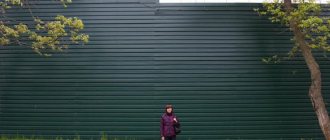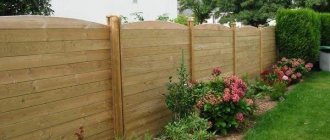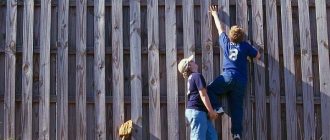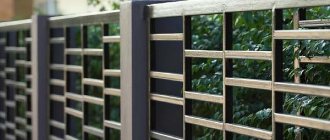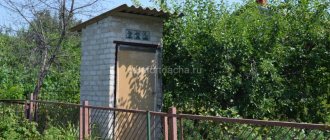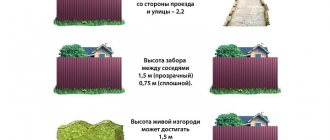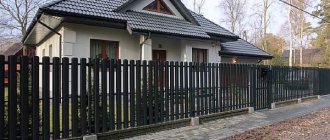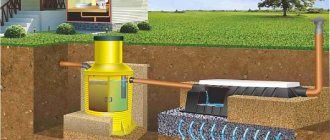The height of the fence is a parameter legally stipulated in SNiP 30-02-97*. Its updated version was adopted in 2021. It is called SP 53.13330.2019 and is mandatory for use on individual housing construction plots according to the law for 2020-2021, other types of land ownership - dacha plots, SNT, private household plots and in populated areas. However, there are also some nuances that stipulate how high the fence between neighbors should be: its material of manufacture, the presence of a mutual written agreement. They may allow fences with deviations from generally accepted requirements.
Vacation home
Categories of land by purpose and type of use
The general concept of private property unites various categories of land owned by citizens. The type of use and category for the intended purpose of the site determines which specific standards, including those in the fencing segment, apply to it. Based on Federal Law No. 217-FZ of July 29, 2017, according to the type of use, land plots are divided into two categories:
- Agricultural land;
- Lands of populated areas.
With the entry into force of the new edition of Federal Law No. 217-FZ, since last year such forms of associations as DNP (dacha independent partnership) and DNT (dacha independent partnership), more simply - dacha partnerships, have ceased to exist. Therefore, today only two forms are allowed on agricultural lands.
- Gardening non-profit partnership - SNT.
- Vegetable gardening non-profit partnership - ONT.
Vegetable gardening is much less common than gardening, since the construction of even garden houses, not to mention permanent ones, is prohibited on plots for vegetable gardens. That is, if you can safely build on a gardening area, register and live all year round, which many people do, then on a plot with a vegetable garden, even overnight you can only stay in a shed with equipment or in a tent. It is logical that owners prefer to settle in comfort and in the gardens. What’s interesting is that you can be the owner of a land plot located on the territory of any SNT, but not be a member of it, since joining is voluntary.
However, the height of the fence between neighboring plots, as well as other parameters (distance to the road, location of capital and non-capital objects, etc.), even without membership, is regulated by the new SP 53.13330.2019 “Planning and development of the territory for gardening by citizens. Buildings and constructions".
But the private sector is not limited to countryside partnerships; on the lands of populated areas, and this is within the city, and in the suburbs, and in country cottage settlements, and in rural and rural settlements, two types of plots are distinguished.
- For individual residential construction - individual housing construction.
- For personal subsidiary plots - private plots (can be not only personal plots, but also field plots).
All aspects of the planning and development of plots on the lands of settlements, whether individual housing construction or private plots, are regulated by SP 55.13330.2016 “Single-apartment residential houses”. But since this code is more focused on the parameters of residential buildings, the height of the fence between neighboring sections of individual housing construction is not specified in it. In this case, the Land Use and Development Rules (LRU) of the specific municipality to which the site belongs apply. And before you start fencing the territory, you need to familiarize yourself with these rules. If the fence is built with obvious violations or in any way causes serious inconvenience to neighbors, you can end up in court proceedings, a fine, or even demolition of the structure.
What should the fence in SNT be like according to the standards?
According to the current SP 53.13330, plots in SNT must be fenced around the entire perimeter - both from the street and along the boundary between neighboring plots. There are also specific recommendations regarding the technical characteristics of fencing:
- The height of the fence between sections is from 1.2 to 1.8 meters;
- The construction of the fence is mesh (it is not specifically stated what exactly is made from chain-link mesh, that is, it could be forging, or 3D panels, or something else that falls under this definition).
At the same time, the joint venture stipulates that it is possible to conclude a written agreement with neighbors, plus, coordinate it with the board of the partnership in order to:
- do without a fence between areas at all;
- make a different type of fence, including one with solid cladding.
It is also possible to install blind, impenetrable fences on the side of streets and driveways, but such a design must be approved by a decision of the general meeting of SNT members.
In our realities, doing without a fence at all is quite problematic - even if the neighbors are wonderful, the relationship is excellent and no conflicts arise, everything can change in one day. And we are not only talking about the neighbor Murka, who suddenly decided to lie in the strawberry patch, but also about sale or inheritance. And installing a fence on an already inhabited area, with a variety of landscaping, is much more problematic than before the improvement.
The key to good neighborly relations and the absence of disputes is compliance not only with the recommendations of the joint venture and standard distances when constructing a fence, but also respect for other people’s interests.
The height of the fence between plots in SNT is especially important when it comes to solid cladding - the higher the fence, the more it shades the yard, and this is the main reason for the ban on solid fencing.
What are the risks of constructing a fence with violations?
In itself, a high permeable fence usually does not cause any complaints, since it neither casts a shadow that negatively affects the plants nor interferes with the movement of air masses. But there is no particular need for the construction of such structures, as well as conflict situations. Whereas high, blank fences are often placed next to each other, either out of a desire to make the yard as private as possible, or to completely close oneself off from neighbors when relations are tense. With the entry into force of the new joint ventures, the number of controversial situations due to height should decrease - the permissible 1.8 meters (versus 1.5 previously) is quite enough to block the view. When you absolutely want something completely silent, you should try to negotiate with your neighbors to conclude an agreement, but in a situation where you have to close yourself off from them, a peaceful settlement is hardly realistic. But it is much more likely that they will wait until the construction of the fence is completed and go to court to get it dismantled.
It is almost impossible to predict how the process will end; our judicial practice is too contradictory, and no one has canceled the saying about the drawbar. Even though the height of the fence between the plots is standard by law, the joint agreements are still advisory in nature, so whether they will force you to demolish the fence and pay the associated legal costs or not is Russian roulette. Almost identical claims filed against property owners who built high, solid fences that do not comply with current standards are both satisfied and denied. To a greater extent, the result will depend on the region, the judicial area, the qualifications of the lawyers involved and the evidence base.
omnipotentForumHouse Member
In SNT it is prohibited to install opaque fences of any height at the boundary between two neighboring plots. However, for the injured party, who in the future will be disturbed by such an opaque fence for some reason, there is nothing legal left but to appeal these actions of the neighbor in court. In this case, it will be necessary to prove that the fence causes harm, a threat to life, etc. Judicial practice on these issues is based purely on evidence; any norms and laws cited as a violation of building codes are usually (with rare exceptions) ignored by the courts.
Therefore, people who are faced with such rudeness from their neighbors choose three paths:
- the first ones who have the balls and a sober attitude take the grinder, and the neighbor’s solid fence lies horizontally on his territory;
- the latter go to the courts and prove that the fence causes them harm and a threat to life and health;
- still others sit under the neighbor’s solid fence, rejoicing that it exists, or grieving that it exists, and don’t go anywhere or do anything.
The situation with individual housing construction is also ambiguous - the height of the fence between plots in the private sector is standardized by local PZZ. But in most cases, local authorities adhere to the standards developed for joint ventures in relation to dimensions and distances, while the use of corrugated sheets as a filling material is generally not prohibited by the rules. Whether in SNT or in the village, compliance with the boundaries of the site is crucial. Even in the absence of other violations, if the fence “drove” into a neighbor’s territory, they will be forced to move it, plus, they will have to pay all the costs associated with the proceedings. If the height of the fence between plots of individual housing construction within the boundaries of settlements almost never becomes the subject of disputes, then the “spade” is the most common cause of conflicts.
Let's sum it up
In areas owned by TSN, installation rules, height and other parameters of the fence are regulated by the organization’s Charter. The previously used SNiP 30-02-97 can be used as a guide, but the standards given in it are advisory in nature.
On the lands of individual housing construction and private plots, the rules regarding fences between neighbors may be regulated by local regulations. If a house in a village or forest stands alone, then there are no restrictions on the height and transparency of the fence. It is imperative to draw up an agreement between neighbors, and build the fence itself strictly along the border of the site.
What to do when you can’t do without a high, blind fence
Despite the fact that it is almost impossible to predict the outcome of the trial due to the large number of variables, even if the plaintiff has an evidence base, the chances of the claim being rejected are much higher in relation to capital structures. A solid fence built on a concrete strip with massive pillars is unlikely to be forced to be dismantled, even if the neighbor has at least half of his yard in the shade and has no crops. The indirect damage from the fence, associated with impaired insolation and ventilation of the area, is too incomparable with the direct costs that the owner of the fence will bear.
When a solid fence is not just desirable, but necessary, there is another way, even in SNT with more stringent standards, to fence off and protect yourself. The mandatory distance from the fence between areas to any structures must be at least one meter, which is what you can play on.
omnipotentForumHouse Member
If this is SNT and solid fences are prohibited at the local level, then corrugated sheeting can be installed ONLY 1 meter from the boundary. Step back a meter and the city is full of fences...
That is, along the boundary, put the most budget mesh fence of the minimum permissible height so that it complies with the rules, and, observing the indentation, already on your territory, put up the desired solid fence, at least 2, at least 2.5 m. Of course, the question of expediency arises here, but when there is a real war between neighbors, it is easier to sacrifice a meter of usable space.
What the law says
Many developers wonder whether it is necessary to go through all the stages? In theory - no, in practice it is necessary. Otherwise, a person who has not received approval may become a victim of circumstances. On the one hand, a lawsuit from neighbors, in which, unfortunately, he will not emerge victorious; on the other hand, a fine from government agencies for lack of a building permit in the amount of 3 to 5 minimum wages, which currently ranges from 33,840 to 56400 rubles. To avoid problems, it is better to act within the framework of existing legislation.
Conclusion
How high the fence between plots is depends on their category; if a joint venture applies to SNT, then within populated areas all parameters are regulated by PZZ. Before building a fence, you should carefully study all the requirements; ignorance is never an excuse. In addition, you can agree on the type of fence and its design with neighbors and the administration (board), having everything documented to avoid problems in the future.
Read more about the distances between objects on the site in one of the previous materials. For example, here is a selection of court decisions on neighbor litigation, including on the issue of fences. In the video - a country wicker fence made by women's hands.
Subscribe to our Telegram channelExclusive posts every week
How does the approval procedure work?
The construction of a fence begins with the precise determination of the boundaries of the site, for which it is necessary to use a boundary cadastral plan. Before construction begins, you will need to meet with your neighbors and discuss with them where the boundary line is.
It is necessary to clarify their plans for construction; if they coincide with yours, it is enough to draw up a conciliation document.
If there are disagreements regarding the boundary, issues are resolved with the involvement of employees of the geodetic organization. Try to resolve all misunderstandings peacefully. Listen to the opinion of the opposite side, perhaps it is worthy of being taken into account.
If it is not possible to develop a common opinion, you will need to go to court, for which you need to have serious arguments. It is recommended to involve lawyers to draw up the application. With the help of a court decision, a neighbor can be involved in the construction of a fence.
